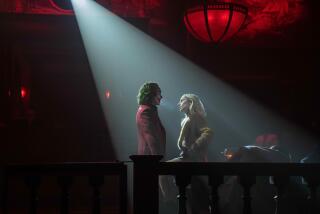Flying, flying and more flying
“Born of a Dream,” the Air Force-produced musical celebrating the centennial of the first airplane flight, remains doggedly earthbound.
The show, which was presented free at the Kodak Theatre on Tuesday and Wednesday, makes only one stab at drama, which begins and ends in the first act. Here it is: A reporter (Steve Wilson) who is assigned to cover the anniversary of the Wright brothers’ achievement in a fictitious small town hates to fly.
He whines about his dilemma in song, but even this solo sheds no light on the source of his aversion to air travel -- no crash in his family’s history, not even a long wait at LAX one Thanksgiving. His reservations expressed, he spends the rest of the show singing along with the citizens of Wrightsville in one joyous salute after another to great moments in aviation. His initial feelings vanish.
This paean to planes is produced by the U.S. Air Force Band, and the performances are sponsored by aviation giant Northrop Grumman, so no one is expecting “Charlie Victor Romeo,” the staged docudrama about the jittery preludes to airplane crashes that played at UCLA in 2001. Still, can’t we hope for a more vibrant simulation of the exhilaration of flight? Imax movies have set a high bar in this department, but the Kodak is supposed to be a theater that can enlist a slew of high-tech devices.
The two attempts to suggest the sensation of flight through visual effects, near the beginning and end of “Born of a Dream,” are wan and dreary. If you’ve never flown, don’t expect this show to inspire you.
The script, by John W. Brooks and Larry MacTaggart, at least avoids becoming an explicit recruiting pageant for the Air Force. Even so, a couple of scenes stray a little off course, most notably a flashback in which a pilot captured in Vietnam and his wife exchange wishes that they could fly to each other’s side.
Though the characters are as flimsy as paper planes, the all-Air Force cast and orchestra sound solid. But the score -- by MacTaggart, John Bliss, Alan Baylock and Robert Thurston -- is usually bland. The musical styles venture into rap at one point, but the lyrics are hardly “fly” in the hip-hop sense of the word.
After enduring songs such as “Why Should I Fly?,” “To Fly,” “Flying, Take Me Flying,” “Let Me Fly” and “In My Mind I Fly,” we should at least have emerged from the theater with some frequent-flier miles.
More to Read
The biggest entertainment stories
Get our big stories about Hollywood, film, television, music, arts, culture and more right in your inbox as soon as they publish.
You may occasionally receive promotional content from the Los Angeles Times.










